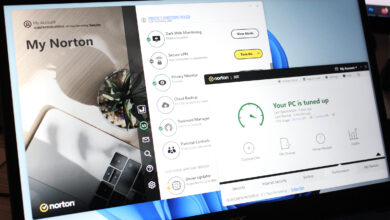35+ Alarming Hacking Statistics [Recently Updated Data]
![35+ Alarming Hacking Statistics [Recently Updated Data]](https://us-news.us/wp-content/uploads/2024/04/43367-35-alarming-hacking-statistics-recently-updated-data-780x470.webp)
Every day, billions of attempts are made to break into your digital space. It’s like an ongoing hide-and-seek game.
Concerning the number of people hacked yearly, around 2,220 cyberattacks are launched daily. This equates to 800,000+ attacks each year.
These hacking statistics aren’t just numbers; they’re snapshots of a digital battlefield where your personal information is the treasure and hackers are the pirates. And it’s not just about stealing secrets; it’s about disrupting your lives, finances, privacy, or everything else.
These facts remind us to be cyber-savvy adventurers, guarding our digital castles with firewalls and strong passwords. They encourage tech wizards to create new spells (better cybersecurity) to keep digital dragons at bay. Although these hacking statistics might shiver down your spine, they also nudge you to stick with your peers in this digital frontier. Let’s look at what the facts tell us.
![Alarming Hacking Statistics and Facts [2024 Updated Data]](https://techreport.com/wp-content/uploads/2024/04/Alarming-Hacking-Statistics-and-Facts-2024-Updated-Data-scaled.webp)
Eye-opening Hacking Statistics
1. Negotiated Credentials Were Involved in 20% of the Cyber Attacks.
One out of every five cyber-attacks happens because someone’s digital keys got stolen. It’s like leaving your house key under the doormat—except it’s your sensitive information at risk instead of your house. These compromised credentials open the door for cyber intruders, giving them a free pass to wreak havoc on your digital life. These statistics remind you to strengthen your passwords, change them every few months, and stay vigilant because protecting your passwords is as essential as locking the doors to your home.
2. New and Small Businesses Report Attacked by Phishing Scams or Hackers Every 11 Seconds.
Within the blink of an eye, a small business somewhere is under siege by an online robber. It takes just 11 seconds for these cyber scoundrels to strike like clockwork, targeting the heart of someone’s entrepreneurial dream. It’s like a relentless game of digital cat and mouse, where these small businesses, often the backbone of communities, are left vulnerable. It’s a stark reminder that in this digital age, safeguarding these businesses isn’t just about protecting profits; it’s about preserving livelihoods and the spirit of entrepreneurship.
3. Human Mistakes or Errors Led to 95% of Data Breaches.
Almost all data breaches happen because of simple human slip-ups. It’s like misplacing keys to a treasure chest—except this treasure chest holds sensitive information. These errors, whether clicking on the wrong link or sharing info where it shouldn’t go, open the floodgates for cyber trouble. It’s not just about machines; regular folks unintentionally leave the back door open for digital intruders. It’s a reminder that behind every breach stat, there’s a missed step, a moment of oversight. But it also means we can tighten these digital locks through awareness and caution.
4. Identifying a Security Breach Takes More Than 206 Days.
Digital security breaches are the hidden leaks of the cyber world, often evading detection for extended periods while attackers operate unnoticed. According to statistics, identifying a network infiltration or data hack takes an average of 206 days. Rather than sudden, overt intrusions, cyber threats typically encroach through incremental, covert means. Hackers lurk in unseen server crevices and buried data folders like shadowy invaders, quietly stealing and unravelling from within. When their presence is uncovered, the confidential damage may already be done. This stark reality check underscores a key truth of the digital domain: an absence of visible threats does not equal safety.
5. Most Americans (Over 56%) Couldn’t do Anything When Their Accounts Were Hacked.
Life online has made all things tech second nature—until something goes wrong. We dread the whole “I got hacked!” nightmare. Shocking data says more than 50% of Americans have no clue what to do if their personal information or accounts get attacked. Can you blame us? It’s like getting lost in a terrifying digital maze with no map to guide you. Getting directly hit by hackers is bad enough. But not knowing where even to start fixing things? That helplessness can paralyze you just as much as the hack itself. Without anyone spelling out the next step options, you feel stranded, grasping for any lifeline to regain control. Even basic awareness around first-response choices could empower everyday folks when disaster strikes. But right now, too many of us are left in the dark.
6. Globally, 78% of Folks Generally Worry About Information Privacy.
You’re not the only one worried about your info floating around the digital universe. Almost 80% of people globally feel anxious about online privacy. Talk about a universal sentiment! It’s a giant, collective whisper questioning who has access to our data and what they do with it. And this isn’t just a random blip of paranoia, either. It’s more like a booming global chorus line echoing shared concerns over how safe our privacy is. These digital jitters cross borders and cultures, too! Billions of voices, different languages, and the same core issue resonate.
7. Almost Half of Individuals Worldwide Believe Their Personal Information is Worthless to Hackers.
Two out of five folks think their data isn’t even on a hacker’s radar. It’s like thinking your spare change isn’t valuable until you realize it’s the key to someone else’s treasure. These two out of five folks might believe their data isn’t gold, but in the hands of hackers, even the smallest puzzle piece can unlock a bigger picture. It’s a wake-up call that our information, no matter how insignificant it may seem, holds immense value in the eyes of those looking to exploit it.
Statistics on Current Hackings

8. 2.2 Million People Have Reported Internet Crimes and Cyberattacks to the FBI in the Past Five Years.
Can you believe the FBI got slammed with over 2.2 million internet crime complaints in the last five years alone? Talk about an unrelenting firehose of SOS digital distress calls! And each number represents a real person getting their online world rocked by hacks, frauds, or privacy attacks. This statistic drives home how inescapably huge the daily cyber threat landscape has become. Our digital lives need some serious extra guards and shields to weather this nonstop storm. And here’s the thing: The internet‘s evolution isn’t slowing down anytime soon, meaning the crimes and schemes mutating out there will get more advanced and relentless, too.
9. In the First Quarter of 2020, Security Breaches Soared by a Staggering 273% Compared to the Same Period in the Previous Year.
Securities breaches have become relentless, like witnessing a sudden avalanche of digital breaches, an alarming surge catching everyone off guard. They represent a sharp spike in cyber intrusions, signalling a growing vulnerability in our digital defences. The 273% rise in these breaches represents a stark wake-up call, underscoring the urgency to stay ahead in the ever-evolving battle against cyber threats. This exponential rise is a stark reminder that the digital landscape is constantly shifting, demanding proactive measures to safeguard against escalating risks.
10. Phishing Websites have Skyrocketed by 130.5% Over the Past Few Years.
The swarm of online trickery has suddenly multiplied, making it harder to spot the real from the fake. Cyber crooks are crafty, setting up these deceitful sites to lure folks in. Hackers are getting better at the game, dishing out more phishing sites, with a hike rate of 130.5% in the past year.
11. Within Just Six Months in 2020, a Mind-blowing 36 Billion Records Got Exposed, Like Whispers of Secrets Suddenly Shouted Out.
Data breaches became overwhelmingly high in 2020, leaving over 36 million records vulnerable to bad players. This surge in breaches screams for better ways to keep our info safe and for everyone to be more aware online.
12. Cyber Thieves all have Price Tags for Our Digital Identities on the Dark Web, With a Social Security Number Going for $1, Passports Reaching up to $2,000, and Credit Card Numbers Selling for About $110.
Your credit card digits can fetch a hacker up to $110, your financial life bundled in digits. Passports and gateways to our world cost up to $2,000—a hefty fee for someone else’s journey into our existence. These alarming values expose the grim reality of online black markets, where personal data becomes currency, emphasizing the dire need for stringent cybersecurity measures and heightened awareness to safeguard our digital identities from such commodification.
Statistics on Hacking Cost

13. The world’s bracing for a digital storm—by 2025, cyber-attacks are set to cause a jaw-dropping $10.5 trillion in damage.
14. Surprisingly, small businesses, though they’re only hit 4% of the time, suffer the most financially, losing around $5.1 million per attack.
15. Identity thefts suck $15 billion from folks’ pockets every year in the US alone. It’s not just money; it’s the turmoil it brings—disrupted lives and shattered trust in our digital systems.
16. In 2019, healthcare took a $25 billion hit from cyber intruders, who breached patient privacy and shaken their faith in the system. Behind these numbers are real stories—heartbreak, financial ruin, and trust shattered into pieces.
17. Each hacked account costs companies an average of $146, a constant drain on their money and reputation. Ransomware’s a cruel captor, demanding an average of $1.85 million per attack, leaving organizations scrambling to recover.
18. Phishing hacks are becoming the most prevalent of all cyber attacks, accounting for approximately 80% of complaints globally.
19. The majority (about 80%) of digital crimes go unreported, with only 5% of cyber criminals receiving punishment for their evil deeds.
However, strong cybersecurity, knowing the risks, and standing strong are your shields and can help you fight hacking. You’ve got to adapt, innovate, and strategize new plans against these digital villains.

20. Over half of hackers use big-name brands or companies to trick their victims. It’s like a wolf in sheep’s clothing—deceiving and playing on your trust.
21. And can you believe it? Out of every 4,200 emails we receive, one could be a sneaky phishing scam. It’s like trying to spot a needle in a haystack, except the needle’s out to get us.
22. Those tricky emails often include attachments ending in .doc or .exe—about 37% and 19.5% of the time, respectively. It’s like they’re hiding danger behind innocent-looking files.
23. 94% of the harmful stuff we get bombarded with comes through emails. It’s like a battlefield right in our inbox.
24. Ever gotten those pop-up surveys or requests online? Well, 1 out of every 13 might be hiding malware. It’s like trying to express interest in something and getting a virus as a ‘thank you’—not exactly what we signed up for.
25. Privacy concerns are hitting hard. Imagine this: around 11% of people have hit the ‘delete’ button on their social media accounts out of worries about privacy.
26. And here’s the kicker—1 in 3 adults in the US don’t trust social media to keep their information safe. It’s like feeling exposed in a crowded room.
27. Also, about 30% of us unintentionally open phishing emails. Of those, 12% end up clicking on the links inside. It’s like stumbling into a trap without realizing it until it’s too late.
Statistics on IoT Hacking

28. Can you imagine? Every month, around 5,200 cyber-attacks hit IoT devices like smart home gadgets. It’s like a constant siege on our digital helpers, disrupting our everyday lives.
29. Surprisingly, nearly 3% of smartphone users have at least one risky app. It’s like having a small crack in our digital armour, leaving a door open for trouble.
30. Get this: on average, it takes just 5 minutes for hackers to break into an IoT device. That’s quicker than making a cup of coffee—a scary reality check.
31. If you’ve got cameras at home, listen to this: almost half of the hacked home devices are cameras. Losing control of our eyes at home is a major invasion of privacy.
32. You might be surprised to hear that most of these attacks come from just a handful of countries—China, the US, Brazil, Russia, and India. It’s like a digital game of tag with these places, each trying to outsmart the other.
33. Here’s a troubling fact: about half of all mobile phone calls are scams. It’s like dodging a barrage of unwanted sales pitches every time the phone rings.
Stats on Historical Hackings and Breaches

34. In 2013, over 3 billion Yahoo accounts were compromised, sending shockwaves online.
35. In 2020, Marriott faced another blow, exposing personal data from 5.2 million guests, following a breach affecting over half a billion accounts just a few years earlier.
36. Equifax’s breach impacted nearly 148 million customers, costing the company $4 billion.
37. Uber‘s 2016 breach affected 57 million users, and to cover it up, they attempted to pay off the hackers—a move that raised serious concerns.
38. But it’s not just about data—2020 marked a tragic turn when a hospital in Germany faced a cyber-hack, causing the world’s first cyber death due to an IT failure. It’s a haunting reminder of the real-life consequences of these cyber threats.
39. Facebook’s 2018 breach affected over 30 million accounts, leaving only a million untouched. It’s like a digital storm where only a fortunate few find shelter while others face the harsh fallout. These breaches aren’t just numbers; they’re stories of lives disrupted, trust shattered, and the daunting realities of our interconnected world.
Conclusion
These hacking statistics aren’t just numbers on a page; they tell stories of trust betrayed, lives upended, and vulnerabilities laid bare. It’s a wake-up call to band together, step up our digital defences, and keep our online world safer. The urgency of beefing up cybersecurity couldn’t be clearer. It’s not just about saving billions for companies; it’s about shielding everyday users from the havoc of cyber assaults. Strengthening these defences isn’t just a financial move; it’s about safeguarding everyone’s digital world from ruthless attacks.


